Theory and Practice: Analyzing JCB's International Business in India
VerifiedAdded on 2023/05/28
|8
|1454
|79
Case Study
AI Summary
This assignment provides a detailed analysis of JCB's international business strategies in India, focusing on their market entry, joint venture with Escorts, and subsequent acquisition of full control. The analysis covers the reasons behind JCB's choice of a joint venture, their decision not to license technology to Escorts, and the potential disadvantages of the joint venture. Furthermore, it elaborates on the advantages JCB gained by obtaining full control of the Indian venture in 2002, including reduced risks, enhanced operational control, and improved global strategic coordination. The study also acknowledges the inherent risks of maintaining overseas operations and adapting to new cultural environments.

Theory and Practice of International Business
Paraphrase This Document
Need a fresh take? Get an instant paraphrase of this document with our AI Paraphraser
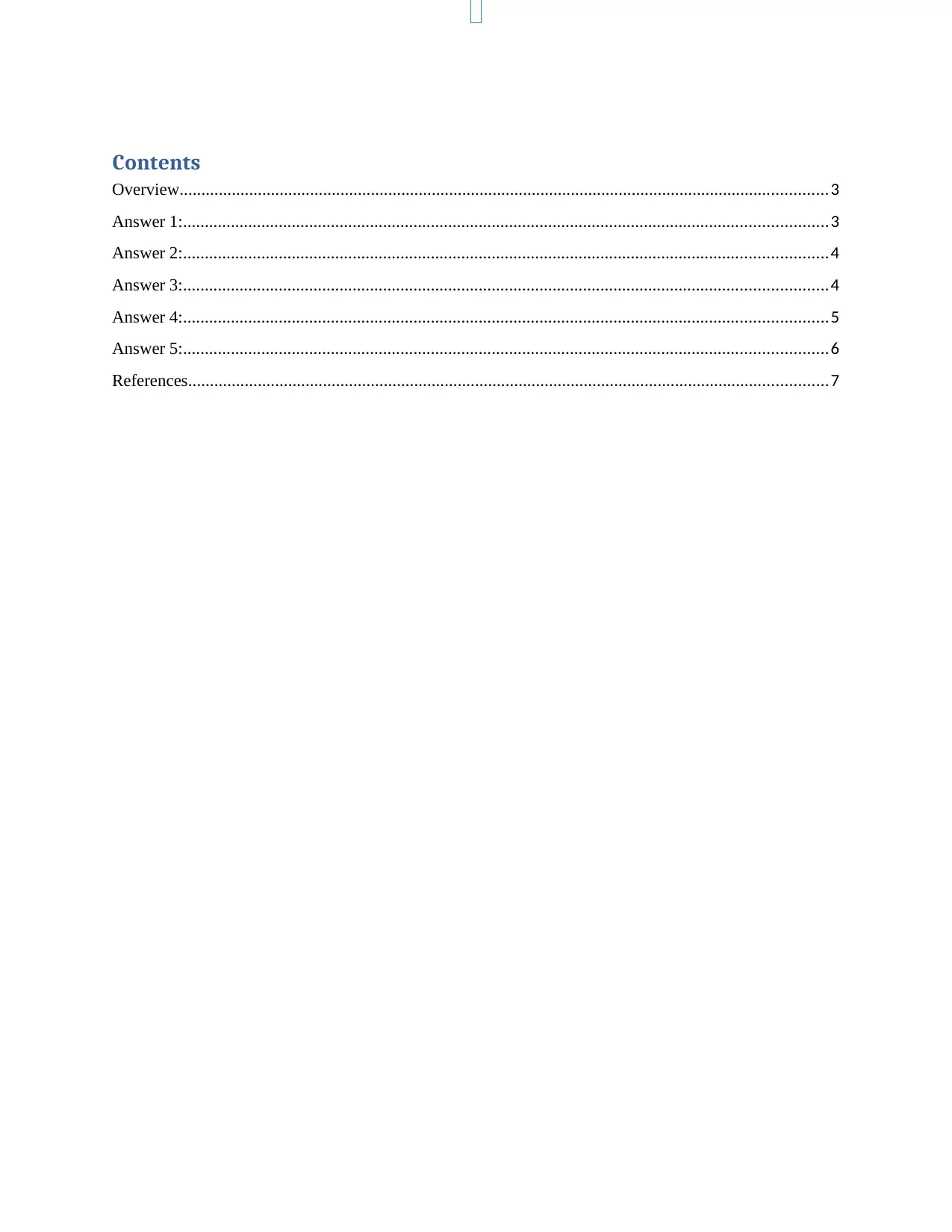
Contents
Overview.....................................................................................................................................................3
Answer 1:....................................................................................................................................................3
Answer 2:....................................................................................................................................................4
Answer 3:....................................................................................................................................................4
Answer 4:....................................................................................................................................................5
Answer 5:....................................................................................................................................................6
References...................................................................................................................................................7
Overview.....................................................................................................................................................3
Answer 1:....................................................................................................................................................3
Answer 2:....................................................................................................................................................4
Answer 3:....................................................................................................................................................4
Answer 4:....................................................................................................................................................5
Answer 5:....................................................................................................................................................6
References...................................................................................................................................................7
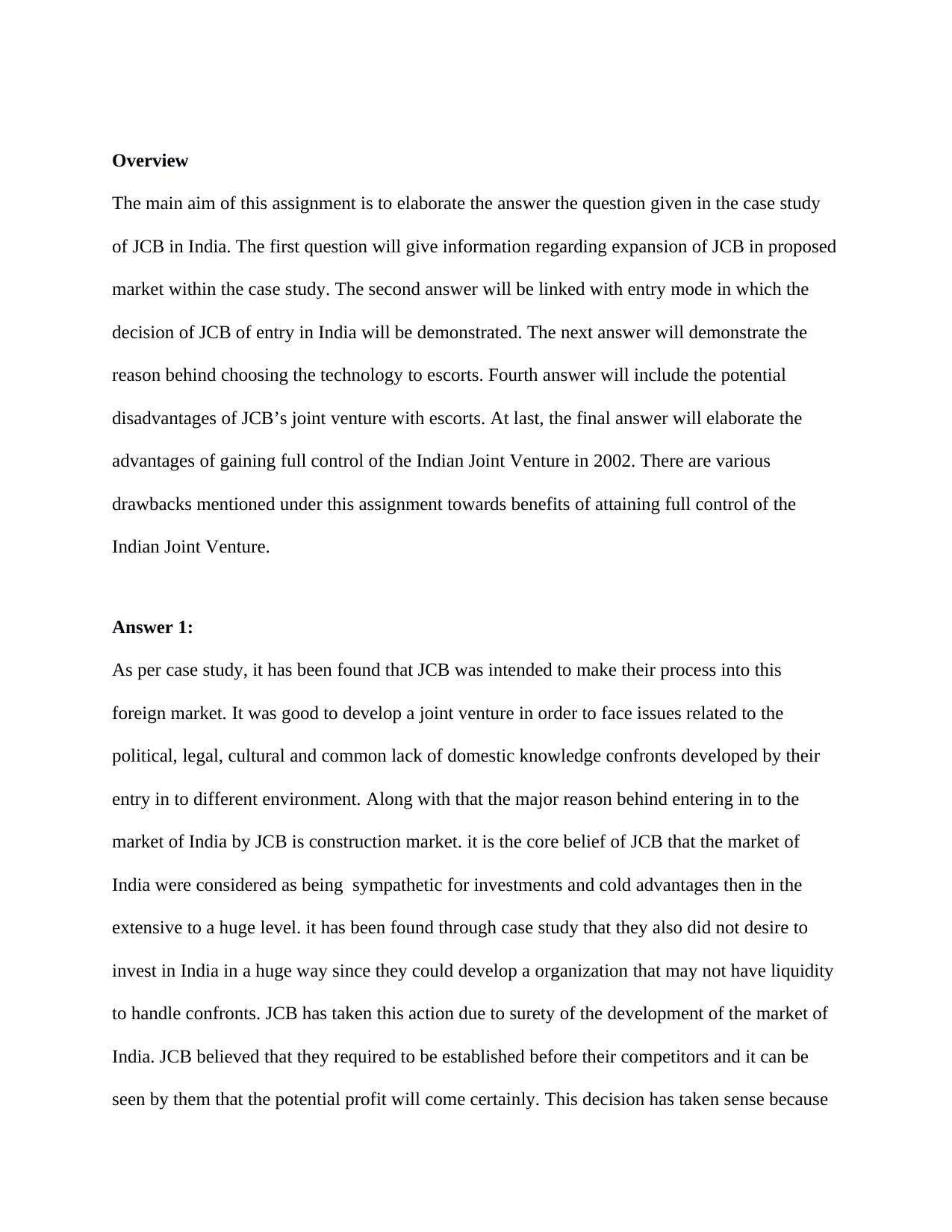
Overview
The main aim of this assignment is to elaborate the answer the question given in the case study
of JCB in India. The first question will give information regarding expansion of JCB in proposed
market within the case study. The second answer will be linked with entry mode in which the
decision of JCB of entry in India will be demonstrated. The next answer will demonstrate the
reason behind choosing the technology to escorts. Fourth answer will include the potential
disadvantages of JCB’s joint venture with escorts. At last, the final answer will elaborate the
advantages of gaining full control of the Indian Joint Venture in 2002. There are various
drawbacks mentioned under this assignment towards benefits of attaining full control of the
Indian Joint Venture.
Answer 1:
As per case study, it has been found that JCB was intended to make their process into this
foreign market. It was good to develop a joint venture in order to face issues related to the
political, legal, cultural and common lack of domestic knowledge confronts developed by their
entry in to different environment. Along with that the major reason behind entering in to the
market of India by JCB is construction market. it is the core belief of JCB that the market of
India were considered as being sympathetic for investments and cold advantages then in the
extensive to a huge level. it has been found through case study that they also did not desire to
invest in India in a huge way since they could develop a organization that may not have liquidity
to handle confronts. JCB has taken this action due to surety of the development of the market of
India. JCB believed that they required to be established before their competitors and it can be
seen by them that the potential profit will come certainly. This decision has taken sense because
The main aim of this assignment is to elaborate the answer the question given in the case study
of JCB in India. The first question will give information regarding expansion of JCB in proposed
market within the case study. The second answer will be linked with entry mode in which the
decision of JCB of entry in India will be demonstrated. The next answer will demonstrate the
reason behind choosing the technology to escorts. Fourth answer will include the potential
disadvantages of JCB’s joint venture with escorts. At last, the final answer will elaborate the
advantages of gaining full control of the Indian Joint Venture in 2002. There are various
drawbacks mentioned under this assignment towards benefits of attaining full control of the
Indian Joint Venture.
Answer 1:
As per case study, it has been found that JCB was intended to make their process into this
foreign market. It was good to develop a joint venture in order to face issues related to the
political, legal, cultural and common lack of domestic knowledge confronts developed by their
entry in to different environment. Along with that the major reason behind entering in to the
market of India by JCB is construction market. it is the core belief of JCB that the market of
India were considered as being sympathetic for investments and cold advantages then in the
extensive to a huge level. it has been found through case study that they also did not desire to
invest in India in a huge way since they could develop a organization that may not have liquidity
to handle confronts. JCB has taken this action due to surety of the development of the market of
India. JCB believed that they required to be established before their competitors and it can be
seen by them that the potential profit will come certainly. This decision has taken sense because
⊘ This is a preview!⊘
Do you want full access?
Subscribe today to unlock all pages.

Trusted by 1+ million students worldwide
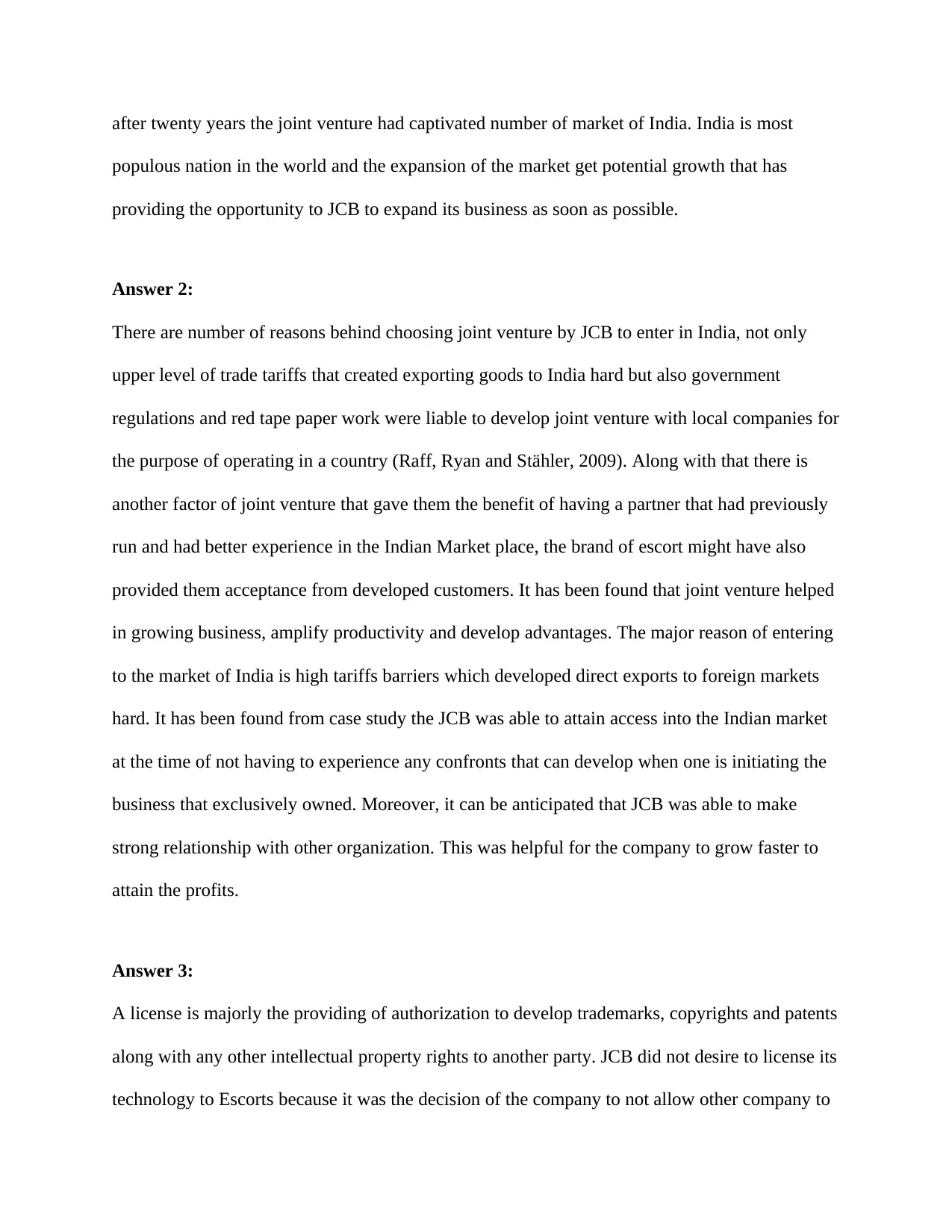
after twenty years the joint venture had captivated number of market of India. India is most
populous nation in the world and the expansion of the market get potential growth that has
providing the opportunity to JCB to expand its business as soon as possible.
Answer 2:
There are number of reasons behind choosing joint venture by JCB to enter in India, not only
upper level of trade tariffs that created exporting goods to India hard but also government
regulations and red tape paper work were liable to develop joint venture with local companies for
the purpose of operating in a country (Raff, Ryan and Stähler, 2009). Along with that there is
another factor of joint venture that gave them the benefit of having a partner that had previously
run and had better experience in the Indian Market place, the brand of escort might have also
provided them acceptance from developed customers. It has been found that joint venture helped
in growing business, amplify productivity and develop advantages. The major reason of entering
to the market of India is high tariffs barriers which developed direct exports to foreign markets
hard. It has been found from case study the JCB was able to attain access into the Indian market
at the time of not having to experience any confronts that can develop when one is initiating the
business that exclusively owned. Moreover, it can be anticipated that JCB was able to make
strong relationship with other organization. This was helpful for the company to grow faster to
attain the profits.
Answer 3:
A license is majorly the providing of authorization to develop trademarks, copyrights and patents
along with any other intellectual property rights to another party. JCB did not desire to license its
technology to Escorts because it was the decision of the company to not allow other company to
populous nation in the world and the expansion of the market get potential growth that has
providing the opportunity to JCB to expand its business as soon as possible.
Answer 2:
There are number of reasons behind choosing joint venture by JCB to enter in India, not only
upper level of trade tariffs that created exporting goods to India hard but also government
regulations and red tape paper work were liable to develop joint venture with local companies for
the purpose of operating in a country (Raff, Ryan and Stähler, 2009). Along with that there is
another factor of joint venture that gave them the benefit of having a partner that had previously
run and had better experience in the Indian Market place, the brand of escort might have also
provided them acceptance from developed customers. It has been found that joint venture helped
in growing business, amplify productivity and develop advantages. The major reason of entering
to the market of India is high tariffs barriers which developed direct exports to foreign markets
hard. It has been found from case study the JCB was able to attain access into the Indian market
at the time of not having to experience any confronts that can develop when one is initiating the
business that exclusively owned. Moreover, it can be anticipated that JCB was able to make
strong relationship with other organization. This was helpful for the company to grow faster to
attain the profits.
Answer 3:
A license is majorly the providing of authorization to develop trademarks, copyrights and patents
along with any other intellectual property rights to another party. JCB did not desire to license its
technology to Escorts because it was the decision of the company to not allow other company to
Paraphrase This Document
Need a fresh take? Get an instant paraphrase of this document with our AI Paraphraser

control on their intellectual property, also providing others the opportunity to copy their
technologies. It has been found that Escorts was known as the largest producers of the industrial
machinery in India which could become the major competitor of JCB. There was a fear in the
mind of JCB that licensing of the company’s technology can Escort make a direct competitor. It
has been found that JCB did not want to connect in licensing its technology to Escorts for the
major cause that if they given Escorts with their ‘know-how’ they could consecutively adapt this
new technology and take in to consideration to accomplish with them. It has been found that it is
the thought that their technology has given a sense of competitive benefit in that area and so, if
accepted on to Escorts, they can become the competitor towards JCB.
Answer 4:
It was the belief of JCB this business strategy will hamper the ability of the company to reach out
to other markets and or enlarge the offering of the products due to joint venture with Escorts
(Beamish, 2013). The company strategy was different from others as it was the belief of the
company that involvement of the company with another company can be the major reason of
their loss of control over the production. JCB considered that the technology in which they
included into their company is the high quality which provided them a key benefit to that of
different same manufacturers; the company was not ready to distinguish competitive advantage
with Escorts. Moreover, the company was not having a distinctive control that would not be
allowed them to compete in number of ways as they have trust that both effective as well as
efficient for the Indian Market which they seen as a vital exploring and a huge changing
economy (Ekabua and Ohaeri, 2013).
technologies. It has been found that Escorts was known as the largest producers of the industrial
machinery in India which could become the major competitor of JCB. There was a fear in the
mind of JCB that licensing of the company’s technology can Escort make a direct competitor. It
has been found that JCB did not want to connect in licensing its technology to Escorts for the
major cause that if they given Escorts with their ‘know-how’ they could consecutively adapt this
new technology and take in to consideration to accomplish with them. It has been found that it is
the thought that their technology has given a sense of competitive benefit in that area and so, if
accepted on to Escorts, they can become the competitor towards JCB.
Answer 4:
It was the belief of JCB this business strategy will hamper the ability of the company to reach out
to other markets and or enlarge the offering of the products due to joint venture with Escorts
(Beamish, 2013). The company strategy was different from others as it was the belief of the
company that involvement of the company with another company can be the major reason of
their loss of control over the production. JCB considered that the technology in which they
included into their company is the high quality which provided them a key benefit to that of
different same manufacturers; the company was not ready to distinguish competitive advantage
with Escorts. Moreover, the company was not having a distinctive control that would not be
allowed them to compete in number of ways as they have trust that both effective as well as
efficient for the Indian Market which they seen as a vital exploring and a huge changing
economy (Ekabua and Ohaeri, 2013).
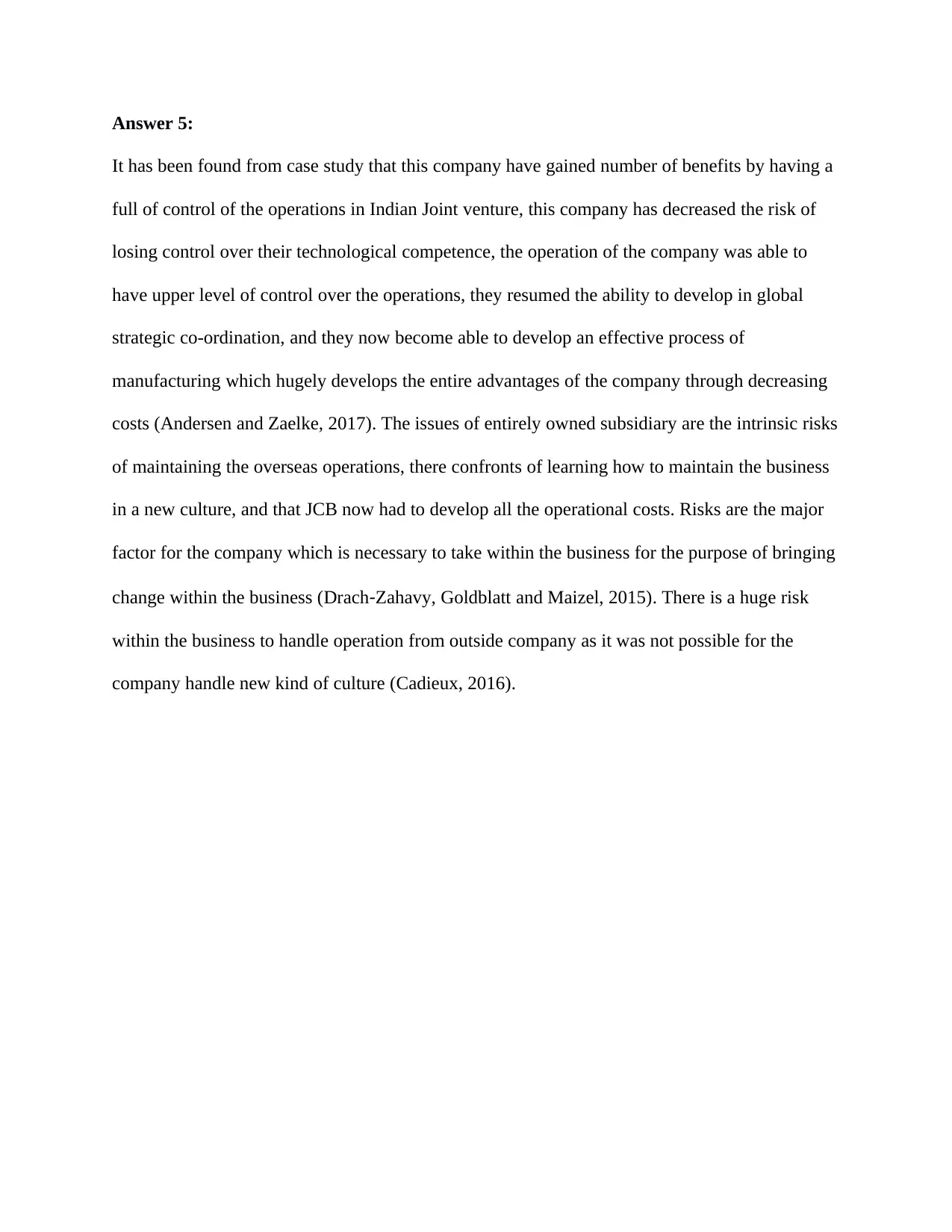
Answer 5:
It has been found from case study that this company have gained number of benefits by having a
full of control of the operations in Indian Joint venture, this company has decreased the risk of
losing control over their technological competence, the operation of the company was able to
have upper level of control over the operations, they resumed the ability to develop in global
strategic co-ordination, and they now become able to develop an effective process of
manufacturing which hugely develops the entire advantages of the company through decreasing
costs (Andersen and Zaelke, 2017). The issues of entirely owned subsidiary are the intrinsic risks
of maintaining the overseas operations, there confronts of learning how to maintain the business
in a new culture, and that JCB now had to develop all the operational costs. Risks are the major
factor for the company which is necessary to take within the business for the purpose of bringing
change within the business (Drach‐Zahavy, Goldblatt and Maizel, 2015). There is a huge risk
within the business to handle operation from outside company as it was not possible for the
company handle new kind of culture (Cadieux, 2016).
It has been found from case study that this company have gained number of benefits by having a
full of control of the operations in Indian Joint venture, this company has decreased the risk of
losing control over their technological competence, the operation of the company was able to
have upper level of control over the operations, they resumed the ability to develop in global
strategic co-ordination, and they now become able to develop an effective process of
manufacturing which hugely develops the entire advantages of the company through decreasing
costs (Andersen and Zaelke, 2017). The issues of entirely owned subsidiary are the intrinsic risks
of maintaining the overseas operations, there confronts of learning how to maintain the business
in a new culture, and that JCB now had to develop all the operational costs. Risks are the major
factor for the company which is necessary to take within the business for the purpose of bringing
change within the business (Drach‐Zahavy, Goldblatt and Maizel, 2015). There is a huge risk
within the business to handle operation from outside company as it was not possible for the
company handle new kind of culture (Cadieux, 2016).
⊘ This is a preview!⊘
Do you want full access?
Subscribe today to unlock all pages.

Trusted by 1+ million students worldwide
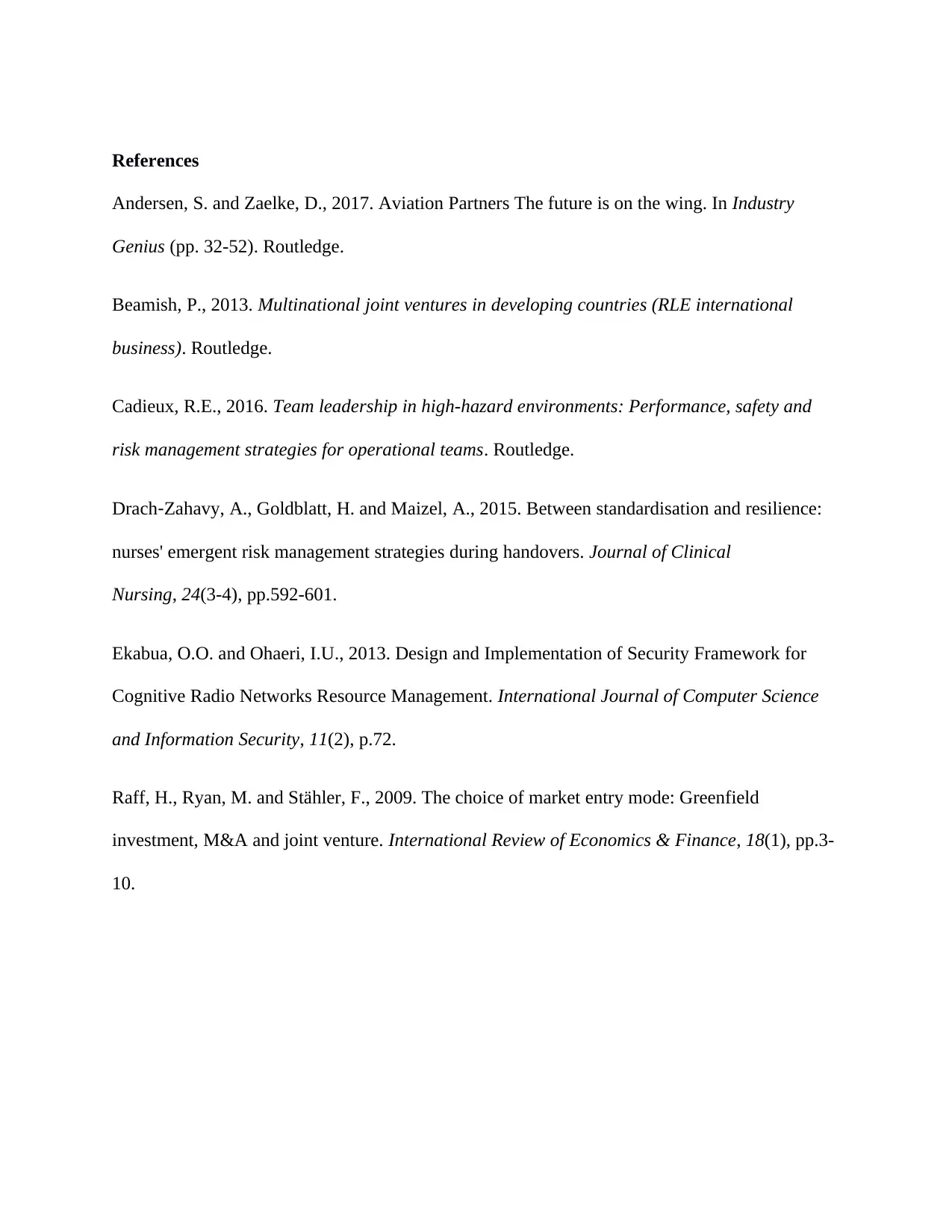
References
Andersen, S. and Zaelke, D., 2017. Aviation Partners The future is on the wing. In Industry
Genius (pp. 32-52). Routledge.
Beamish, P., 2013. Multinational joint ventures in developing countries (RLE international
business). Routledge.
Cadieux, R.E., 2016. Team leadership in high-hazard environments: Performance, safety and
risk management strategies for operational teams. Routledge.
Drach‐Zahavy, A., Goldblatt, H. and Maizel, A., 2015. Between standardisation and resilience:
nurses' emergent risk management strategies during handovers. Journal of Clinical
Nursing, 24(3-4), pp.592-601.
Ekabua, O.O. and Ohaeri, I.U., 2013. Design and Implementation of Security Framework for
Cognitive Radio Networks Resource Management. International Journal of Computer Science
and Information Security, 11(2), p.72.
Raff, H., Ryan, M. and Stähler, F., 2009. The choice of market entry mode: Greenfield
investment, M&A and joint venture. International Review of Economics & Finance, 18(1), pp.3-
10.
Andersen, S. and Zaelke, D., 2017. Aviation Partners The future is on the wing. In Industry
Genius (pp. 32-52). Routledge.
Beamish, P., 2013. Multinational joint ventures in developing countries (RLE international
business). Routledge.
Cadieux, R.E., 2016. Team leadership in high-hazard environments: Performance, safety and
risk management strategies for operational teams. Routledge.
Drach‐Zahavy, A., Goldblatt, H. and Maizel, A., 2015. Between standardisation and resilience:
nurses' emergent risk management strategies during handovers. Journal of Clinical
Nursing, 24(3-4), pp.592-601.
Ekabua, O.O. and Ohaeri, I.U., 2013. Design and Implementation of Security Framework for
Cognitive Radio Networks Resource Management. International Journal of Computer Science
and Information Security, 11(2), p.72.
Raff, H., Ryan, M. and Stähler, F., 2009. The choice of market entry mode: Greenfield
investment, M&A and joint venture. International Review of Economics & Finance, 18(1), pp.3-
10.
Paraphrase This Document
Need a fresh take? Get an instant paraphrase of this document with our AI Paraphraser

1 out of 8
Related Documents
Your All-in-One AI-Powered Toolkit for Academic Success.
+13062052269
info@desklib.com
Available 24*7 on WhatsApp / Email
![[object Object]](/_next/static/media/star-bottom.7253800d.svg)
Unlock your academic potential
Copyright © 2020–2025 A2Z Services. All Rights Reserved. Developed and managed by ZUCOL.



